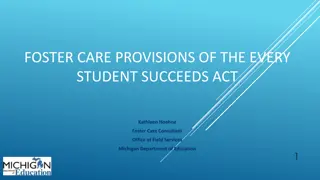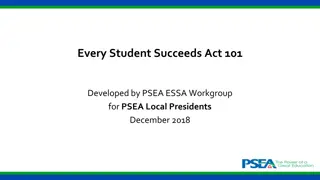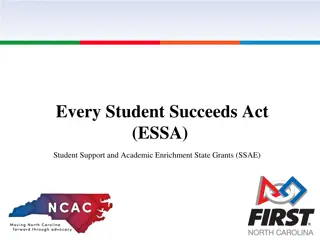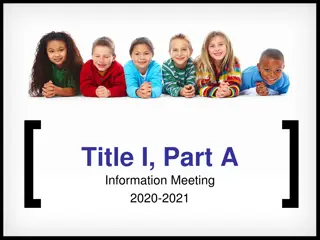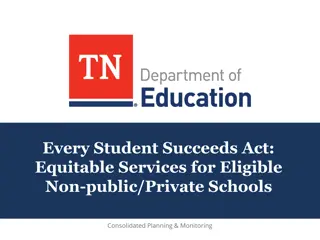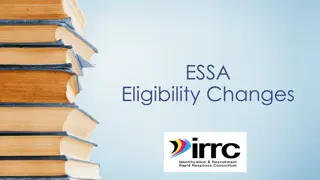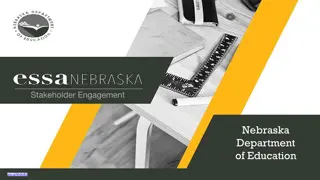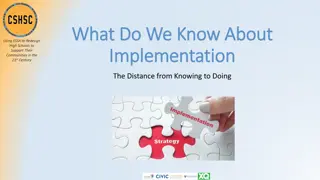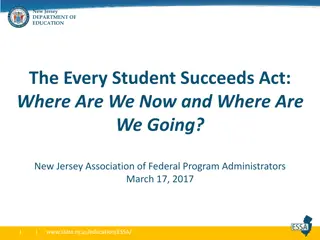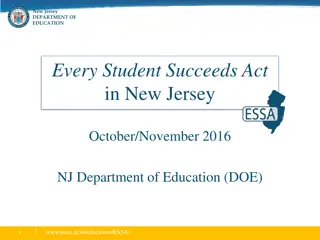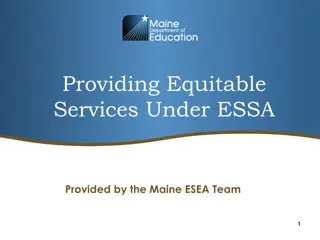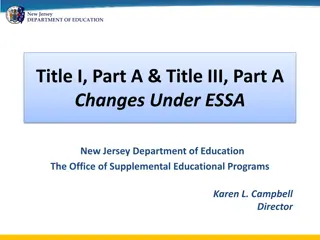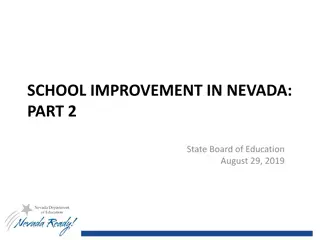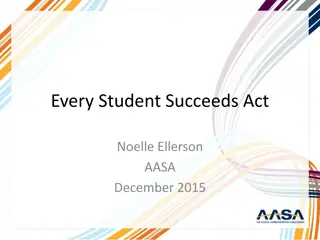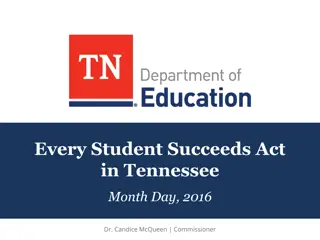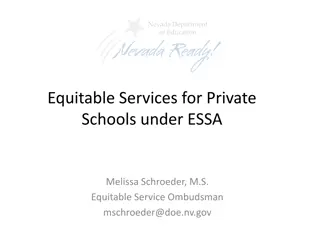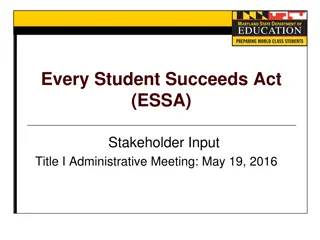Understanding Every Student Succeeds Act (ESSA) Testing Guidelines for Families
ESSA requires states to set challenging academic standards and conduct annual tests aligned with those standards. Parents have a say in choosing the standards and tests for their children. Flexibilities exist for eighth-grade math tests, high school tests, and innovative testing approaches, offering options for students to demonstrate proficiency in different ways.
Download Presentation

Please find below an Image/Link to download the presentation.
The content on the website is provided AS IS for your information and personal use only. It may not be sold, licensed, or shared on other websites without obtaining consent from the author. Download presentation by click this link. If you encounter any issues during the download, it is possible that the publisher has removed the file from their server.
E N D
Presentation Transcript
Build Your Own ESSA Explainer Need to communicate key facts and details about what the Every Student Succeeds Act (ESSA) means for families? Use these slides to build your own presentation. Each card summarizes something about the law that parents should know, including how ESSA approaches standards and assessments, funding flexibilities, and more. The content for this deck comes from Understanding the Every Student Succeeds Act: A Parents Guide to the Nation s Landmark Education Law.
WHAT ESSA SAYS ABOUT Tests IN A NUTSHELL WHAT THAT MEANS FOR YOU ESSA requires every State to develop challenging academic standards that specify the knowledge and skills that the State expects all its students to achieve, and to administer annual tests aligned with those After consulting with parents, teachers, and other stakeholders, your state has the freedom to choose the standards that describe the knowledge and skills every child in your State is taught, and the tests that will let you and your child s teachers know whether your child has achieved those standards. standards.
TESTS TESTS Eighth-Grade Math Tests IN A NUTSHELL A State that administers end-of-course math tests in high school may excuse any eighth-grade student from the State s eighth-grade math test if the student takes the end-of-course test the State typically administers in high school instead. To receive this flexibility, the State must commit to administering to the student a more rigorous math test in high school. WHAT THAT MEANS FOR YOU If your eighth-grader is taking a high school-level math class and test, he or she is not required to take the State math test other eighth-grade students take.
TESTS TESTS High School Tests IN A NUTSHELL A State may allow a district to administer a locally selected, nationally recognized high school test in place of the statewide test in math, reading/language arts, or science. WHAT THAT MEANS FOR YOU Your high school student may be able to take a nationally recognized high school test, such as the ACT or SAT, instead of the test your State normally administers in high school.
TESTS TESTS Innovative Testing IN A NUTSHELL A State may apply to the U.S. Department of Education to implement innovative tests in some of its districts instead of the statewide test. WHAT THAT MEANS FOR YOU If your child attends a school in a district in a State that receives this flexibility, he or she may take a different type of test in place of the standardized tests the State would otherwise administer.
TESTS TESTS Personalized Testing IN A NUTSHELL A State may administer its tests in the form of computer-adaptive tests, which adapt or adjust by increasing or decreasing in difficulty based on a student s responses to questions on the test in real time. This type of adaptive test allows a State to measure a student s knowledge more quickly and with more precision. WHAT THAT MEANS FOR YOU Your child may take the required State tests using a computer program that adapts test questions based on how your child is doing on each question (i.e., gets more challenging if your child answers correctly or less challenging if your child answers incorrectly).
TESTS TESTS Tests for Students With the Most Significant Cognitive Disabilities IN A NUTSHELL A State may adopt alternate academic achievement standards and alternate tests that measure achievement of those standards for students with the most significant cognitive disabilities. A State may administer an alternate test that is aligned to alternate academic achievement standards to no more than 1 percent of its tested students. WHAT THAT MEANS FOR YOU If your child is a student with the most significant cognitive disabilities, as defined by your state, it may be appropriate for your child to be tested with an alternate assessment. This determination will be an individualized decision, with your input, based on your child s individual and unique needs.
WHAT ESSA SAYS ABOUT WHAT ESSA SAYS ABOUT Accountability IN A NUTSHELL WHAT THAT MEANS FOR YOU Every State is required to develop an accountability system for all public schools to improve student achievement and school success, but the State has broad discretion in designing its system. Your State may select a number of measures to assess the performance of each public school. For example, in addition to performance on statewide tests and graduation rate, your State may select such measures as chronic absenteeism or student growth. It is important that your State helps you understand what measures it uses to evaluate schools so that you understand the performance of your child s school and other schools.
ACCOUNTABILITY ACCOUNTABILITY Recently Arrived English Learners IN A NUTSHELL A State has three options for how to include recently arrived English learners in its statewide accountability system. WHAT THAT MEANS FOR YOU If your child is an English learner and has attended a school in the United States for less than 12 months, he or she may not have to take all of the required standardized tests. If he or she takes the tests, your State may choose not to include his or her score in the same way as all of the other scores when the State evaluates the school s performance.
ACCOUNTABILITY ACCOUNTABILITY Former English Learners IN A NUTSHELL A State may include former English learners in the subgroup of English learners for certain purposes within its accountability system for up to four years. WHAT THAT MEANS FOR YOU If your State takes advantage of this flexibility in evaluating the performance of English learners in your child s school, the State will give your school credit for the performance of students who were previously English learners but have achieved English language proficiency within the last few years.
WHAT ESSA SAYS ABOUT WHAT ESSA SAYS ABOUT School Support and Improvement IN A NUTSHELL WHAT THAT MEANS FOR YOU A State is required to identify three categories of schools: (1) those needing comprehensive support and improvement; (2) those needing targeted support and improvement; and (3) those needing additional targeted support and improvement. The schools that must be identified for comprehensive support and improvement are the lowest-achieving 5 percent of Title I schools, high schools that have a graduation rate below 67 percent, and additional targeted support and improvement schools that do not improve. A State has some flexibility in how it identifies schools for targeted support and improvement, but generally identifies these schools based on the performance of individual subgroups of students, such as by race, free or reduced- price lunch status, or students with disabilities. Your State and district are required to include on their annual report cards a list of all schools that are identified for comprehensive or targeted support and improvement. You can check those report cards to see if your child s school has been identified as needing comprehensive or targeted support.
SCHOOL SUPPORT & IMPROVEMENT SCHOOL SUPPORT & IMPROVEMENT School Improvement Activities IN A NUTSHELL A district is required to develop a plan for each school that the State identifies as needing comprehensive support and improvement, but the district has the freedom to identify the evidence-based interventions it will include in each plan. Likewise, each school that a State identifies as needing targeted support and improvement has the freedom to identify the evidence-based interventions it will include in its targeted support and improvement plan. WHAT THAT MEANS FOR YOU Because ESSA requires districts and schools to involve parents in developing comprehensive and targeted support and improvement plans, you can help your district or school determine the evidence-based interventions that are best suited to meet the needs of students in your child s school.
SCHOOL SUPPORT & IMPROVEMENT SCHOOL SUPPORT & IMPROVEMENT Alternative High Schools IN A NUTSHELL A State may permit different improvement activities for high schools that serve students who have previously dropped out or who are at risk of dropping out. WHAT THAT MEANS FOR YOU Your State can permit high schools that are designed to serve students who have previously dropped out or who are at risk of dropping out to implement improvement activities that are specifically tailored to the unique needs of these students.
SCHOOL SUPPORT & IMPROVEMENT SCHOOL SUPPORT & IMPROVEMENT Public School Choice IN A NUTSHELL A district may offer students enrolled in a school identified for comprehensive support and improvement the option to transfer to another public school. A district may also use up to 5 percent of its Title I Part A funds to pay for transportation of students who take advantage of this choice. WHAT THAT MEANS FOR YOU If your child attends a school the State identifies for comprehensive support and improvement, your district may allow your child to transfer to another public school and use a portion of its Federal funds to pay for transportation to the public school you choose for your child.
SCHOOL SUPPORT & IMPROVEMENT SCHOOL SUPPORT & IMPROVEMENT School Improvement Funds IN A NUTSHELL A State may determine how to distribute school improvement funds. A district with one or more schools identified for comprehensive or targeted support and improvement has the flexibility to determine whether to apply for school improvement funds and, if so, to determine how much funding it requests, for which school or schools it requests funds, and whether to seek funding for district-level activities. WHAT THAT MEANS FOR YOU Your State can decide whether it would be more beneficial to distribute funds for the lowest-performing schools and schools with low-performing subgroups based on a formula or to have districts compete for the funding. Whichever method your State chooses, your district can choose whether to apply for the funds and, if so, the schools for which it will seek the funds and the activities it will support with the funds.
WHAT ESSA SAYS ABOUT Student-Focused Activities IN A NUTSHELL WHAT THAT MEANS FOR YOU A State may reserve some of its federal funding for direct student services that include, for example, activities that help students complete advanced or career and technical education coursework, or the cost of transportation for students to transfer to public schools not identified as among the lowest- performing schools. A district also can decide if it wants to apply for these funds and, if so, which direct student services it will implement. If your State chooses to reserve Federal funds for direct student services, your district may be able to receive some of those funds and offer services that it otherwise couldn t, such as enabling students to enroll in different courses or allowing students in the lowest-performing schools to choose to attend higher-performing public schools.
WHAT ESSA SAYS ABOUT Charter Schools IN A NUTSHELL WHAT THAT MEANS FOR YOU Charter schools are free public schools of choice exempt from certain State or local rules and regulations. The U.S. Department of Education awards grants to eligible entities, including States, charter management organizations, and charter developers, to create and expand charter schools. Grantees have the freedom to develop their charter school programs, including their mission, curriculum, teaching methods, and other aspects of the school. Your State and nonprofit organizations that develop charter schools can apply for Federal funds to create and expand charter schools to which parents can choose to send their children. Charter schools are free public schools of choice exempt from certain State or local rules and regulations.
WHAT ESSA SAYS ABOUT Funding Flexibility IN A NUTSHELL WHAT THAT MEANS FOR YOU States and districts have flexibility related to certain funds under the ESSA, including the flexibility to consolidate or transfer certain funds, flexibility to combine certain Federal funds with State and local resources, and flexibility in how they use certain Your State and district have some flexibility to use Federal funds in ways that may better meet student needs. funds.
FUNDING FLEXIBILITY FUNDING FLEXIBILITY Student-Centered Funding Pilot IN A NUTSHELL A district may apply for flexibility that would allow it to combine certain funds in a way that may enable the district to better support students, particularly high-need students, such as children from low-income families, English learners, and children with disabilities. WHAT THAT MEANS FOR YOU Your district may apply to the U.S. Department of Education to participate in the student-centered funding pilot, which permits the district to combine certain Federal funds with State and local funds and to distribute resources to schools in a way that better meets the needs of students. The district would receive significant flexibility from meeting many Federal requirements of the programs it combines.
FUNDING FLEXIBILITY FUNDING FLEXIBILITY Ensuring That Federal Funds Supplement State and Local Funds IN A NUTSHELL If your child attends a school that receives Federal Title I money, the law requires that your school also receive all of the State and local money it would receive even if it did not receive Title Imoney. So, the district s allocation of State and local funds must be Title I-neutral. WHAT THAT MEANS FOR YOU Federal funds are intended to provide additional services to schools that receive them. A district has flexibility in how it demonstrates that it uses Title I Part A funds to show they are in addition to State and local funds. A district does not need to identify specific uses of Title I Part A to do so.
FUNDING FLEXIBILITY FUNDING FLEXIBILITY Title I School Wide Programs IN A NUTSHELL A State may allow your child s school to operate a school wide Title I program if your State believes that will better serve students, even if the school s poverty rate is below 40 percent. WHAT THAT MEANS FOR YOU A Title I school is a school that serves high concentrations of economically disadvantaged students. A Title I school with a poverty rate of 40 percent or more may operate a school wide program meaning it can use its funds to support all students in the school and may consolidate Federal, State, and local funds to better serve its students. A State may grant a waiver to a school with a poverty rate below 40 percent to operate a school wide program if the State thinks a school wide program will better serve students.
FUNDING FLEXIBILITY FUNDING FLEXIBILITY Flexibility for Rural Schools IN A NUTSHELL A district that is eligible for the Small, Rural School Achievement (SRSA) program has flexibility in using the funding it receives under certain other Federal education programs. WHAT THAT MEANS FOR YOU If your district is eligible for the SRSA program, it has flexibility in how it uses the funding it receives under certain other Federal education programs to best meet the needs of its students.
SUPPORTING LOCAL REFORM SUPPORTING LOCAL REFORM State Flexibility* IN A NUTSHELL A State, with approval from the U.S. Department of Education, may waive certain Federal education requirements that may impede local reform efforts. WHAT THAT MEANS FOR YOU Your State may be able to exempt your district from many Federal requirements in order to improve the academic achievement of children in your school and district. *This is often referred to as Ed Flex.
SUPPORTING LOCAL REFORM SUPPORTING LOCAL REFORM Waivers IN A NUTSHELL The U.S. Secretary of Education may waive many Federal requirements for ESSA programs if a State demonstrates that a waiver would advance student academic achievement. WHAT THAT MEANS FOR YOU Your State may request a waiver of certain Federal requirements if releasing the State, or certain districts in the State, from those requirements would help to improve student academic achievement.
Next Steps To learn more, or to encourage your State or district to take advantage of these flexibilities, you can: o Contact your State: www.ed.gov/about/contacts/state/index.html o Read your State s ESSA Plan: www.ed.gov/admins/lead/account/stateplan17/statesubmission.html o Contact your local school district. o Attend your local school board meeting, and voice your opinion about these issues.



